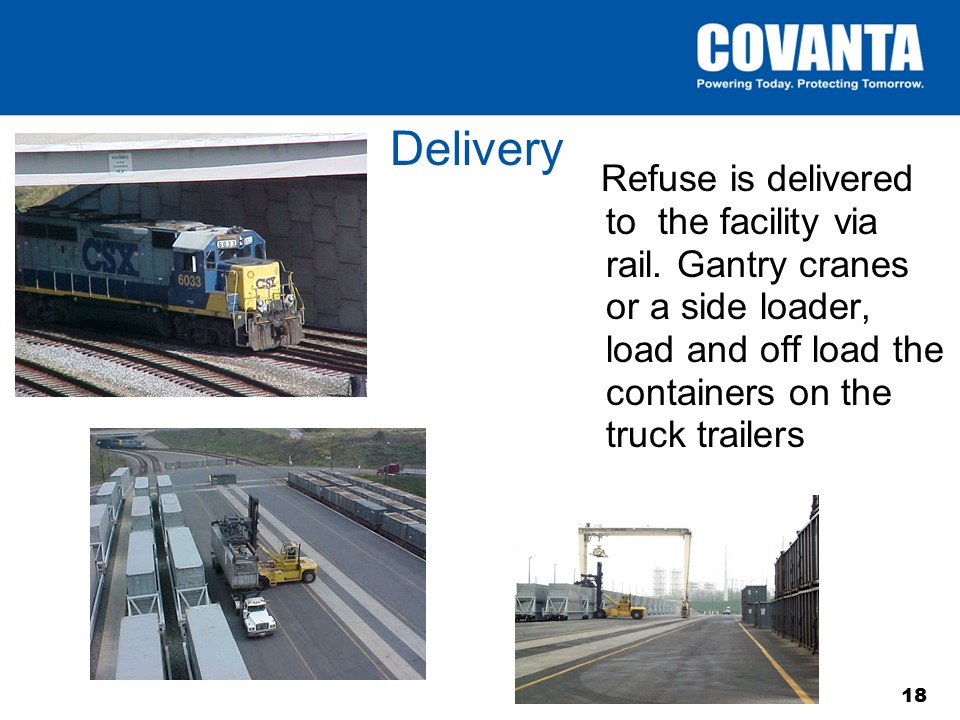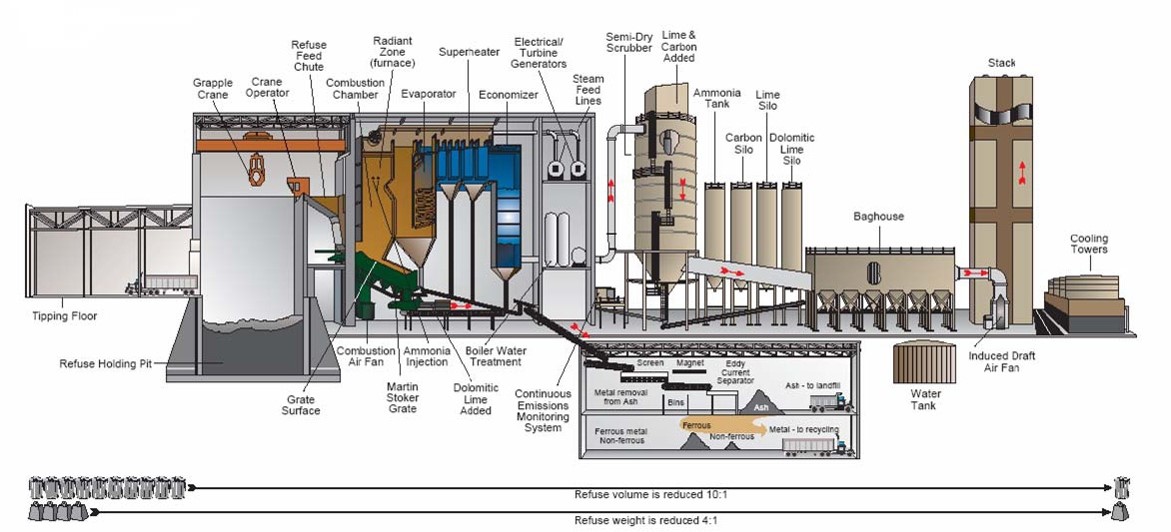On Friday, October 23, 2015, at Town Hall, Poolesville Green hosted its latest talk in the “What’s It All About” series of informational workshops.
The topic was Montgomery County’s Resource Recovery Facility (Covanta) and the county’s energy-from-waste program, which was presented by Mark Freedman, Covanta Montgomery’s Business Manager.
When residents think of Covanta, the term “incinerator” may come to mind, along with the image of smoke stacks from decades past which spewed black fumes, carcinogenic ash, and a bad stench into the air. What we learned from the talk, however, is that Covanta’s state-of-the-art facility, equipped with the most rigorous of air pollution control systems, safely converts waste into clean, renewable energy.
In operation for 20 years now, Covanta’s Montgomery County Resource Recovery Facility, located off of Martinsburg Road in Dickerson, has been processing an average of 1,800 tons of solid waste daily, while generating up to a net 52 megawatts of electricity, enough to power 37,000 homes.
Montgomery County appears to have put quite a bit of thought into the design of its solid waste management plan with an emphasis on sustainability. In 2000, its Resource Recovery Facility (RRF) was given the “Waste-to-Energy Facility of the Year” award by the American Society of Mechanical Engineers, Solid Waste Processing Division.
So what happens to your trash after you place it on the curb? (Did you know it goes on a train ride?)
 All of the county’s trash is first delivered to the Shady Grove Transfer Station in Derwood where it is compacted into waste containers. Each day, these containers are loaded onto train cars and transported 22-miles to an enclosed building at the Dickerson facility. The use of the rail system eliminates the truck traffic on rural roads, in particular Route 28, as well as the emissions that would be associated with all the diesel trucks traveling to the facility.
All of the county’s trash is first delivered to the Shady Grove Transfer Station in Derwood where it is compacted into waste containers. Each day, these containers are loaded onto train cars and transported 22-miles to an enclosed building at the Dickerson facility. The use of the rail system eliminates the truck traffic on rural roads, in particular Route 28, as well as the emissions that would be associated with all the diesel trucks traveling to the facility.
In the “incinerator,” the RRF uses a mass combustion technology where waste is burned at temperatures exceeding 1800 degrees Fahrenheit and reduced to an inert ash residue that is about 10% of its original volume. The heat from combustion boils water and generates steam, which turns a turbine-driven generator to produce electricity. The electricity generated is distributed to the grid.
What is done to keep the pollutants generated by combustion out of the air?
The energy-from waste (EfW) industry is highly regulated, more so than the coal and oil utilities. The RRF uses state-of-the-art emissions control technologies to treat the air from the combustion chamber of the boilers. A carbon-injection system removes mercury and dioxins/furans. An ammonia-injection system removes nitrous oxides. Lime injection controls acid gases, in addition to a dry flue gas scrubber and fabric filter baghouse that control acid gases and particulate emissions. Covanta also utilizes a MARTIN Combustion Control system for carbon monoxide as well as a Low NOx system.
The RRF uses state-of-the-art emissions control technologies to treat the air from the combustion chamber of the boilers. A carbon-injection system removes mercury and dioxins/furans. An ammonia-injection system removes nitrous oxides. Lime injection controls acid gases, in addition to a dry flue gas scrubber and fabric filter baghouse that control acid gases and particulate emissions. Covanta also utilizes a MARTIN Combustion Control system for carbon monoxide as well as a Low NOx system.
After passing through the multi-step air pollution control system, what goes up the stack is clean gas. According to Freedman, what you see coming out is just “steam,” and it is distinguishable from a smoke plume because it is detached from the stack. The county monitors the emissions continuously (every 10 seconds) and the data is available for view on its website: http://www.montgomerycountymd.gov/sws/facilities/rrf/cem-detail.html.
**It may be worth noting that the emissions from the RRF plant should not be confused with the emissions visible from the neighboring NRG Energy Dickerson plant, a coal-fired power station, also located on Martinsburg Road, which reportedly has plans to shut down operations in 2017.
Finally, what about the solid ash? The fly ash that is collected in the baghouse is wet down and cooled, then exposed to a powerful magnet that pulls out the metals that can be recycled. The final solid material is shipped out to a landfill in Richmond, Virginia where it provides the mandated 6” daily cover of inert material.
Freedman also addressed the topic of potential health risks associated with the RRF emissions. He cited studies commissioned by Montgomery County Department of Public Works and Transportation, Division of Solid Waste Services and reviewed by the US Environmental Protection Agency. Air and non-air samples from nearby areas continue to be monitored (every 3 years and 5 years, respectively), and the numbers have consistently shown that the relative risk of harm to human health is very low and that the RRF does not pose unacceptable risks to the surrounding community.
After describing the Covanta Montgomery facility, Freedman went on to discuss waste management on a global level. He shared data comparing the environmental effects of EfW versus landfilling. EfW uses less land per megawatt than other renewable energy sources. EfW also reduces the amount of greenhouse gases in the air compared to landfilling, mainly by eliminating the release of methane gas (which is about 30 times more potent than carbon dioxide) that would occur in a landfill.
Data showing where the US stands globally with regard to EfW vs. landfilling was also presented. Compared to Europe, which has successfully eliminated or reduced landfills and implemented effective EfW technologies, the US still landfills 64% of its trash.
We’ve all heard the mantra “Reduce, Reuse, Recycle.” According to Freedman, Montgomery County does a very good job at recycling. The county’s solid waste services also promote “reuse” programs at the Transfer Station (e.g., bicycles, paint, and building materials). There are organizations such as ![]() , a nonprofit that redistributes used furniture and home goods to families in need. However, he says, as a society we are not doing a very good job of “reducing” trash volume. Convenience demands the excessive use of plastic and other materials that end up in the trash. Until the volume of trash is reduced, EfW will continue to be considered a “renewable” energy source.
, a nonprofit that redistributes used furniture and home goods to families in need. However, he says, as a society we are not doing a very good job of “reducing” trash volume. Convenience demands the excessive use of plastic and other materials that end up in the trash. Until the volume of trash is reduced, EfW will continue to be considered a “renewable” energy source.
In an ideal world, from an environmental perspective, we would produce much less trash. However, until we can solve that problem, EfW appears to be a responsible and sustainable solution for both waste management and renewable energy.
More Photos: Poolesville Green Google+



